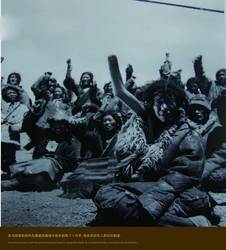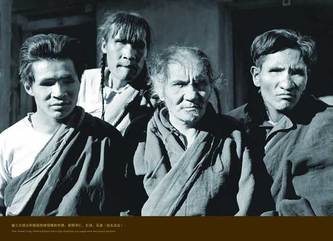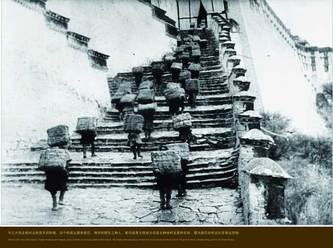How do Chinese and Western media view China-Tibet relation?
Diverge: Serf System
Introduction
Whenever talking about Old Tibet, Chinese main-stream media will use the words "a system which allows people to eat people" to describe the extreme inequality of feudal serf system. Then it comes as no surprise that the serf system is the only aspect of life in Old Tibet Chinese media is willing to foucs on. This logic here is simple and obvious. If there existed brutal system before 1959 and this system has been deracinated after 1959, the public can arrive at the conclusion by themselves that what happened in 1959 was a Democratic Reform, just as the Chinese government hopes the public to believe.
In this section, we will first see the description of serf system from Chinese main-stream media. More than usual, words are not as persuasive as pictures. China initiated a large-scale propaganda in 2009, "50th Anniversary of Democratic Reform in Tibet Picture Exhibition”, intending to educate the public on the history and change of Tibet. Examining some parts of this exhibition will give us some sense about how Chinese media shapes its description about China-Tibet relation. Then we will take a glance at Western version. Finally, I will compare Chinese and Western Media' versions and explore how and why they diverge.
Whenever talking about Old Tibet, Chinese main-stream media will use the words "a system which allows people to eat people" to describe the extreme inequality of feudal serf system. Then it comes as no surprise that the serf system is the only aspect of life in Old Tibet Chinese media is willing to foucs on. This logic here is simple and obvious. If there existed brutal system before 1959 and this system has been deracinated after 1959, the public can arrive at the conclusion by themselves that what happened in 1959 was a Democratic Reform, just as the Chinese government hopes the public to believe.
In this section, we will first see the description of serf system from Chinese main-stream media. More than usual, words are not as persuasive as pictures. China initiated a large-scale propaganda in 2009, "50th Anniversary of Democratic Reform in Tibet Picture Exhibition”, intending to educate the public on the history and change of Tibet. Examining some parts of this exhibition will give us some sense about how Chinese media shapes its description about China-Tibet relation. Then we will take a glance at Western version. Finally, I will compare Chinese and Western Media' versions and explore how and why they diverge.
Serf System in Tibet: Chinese Media's version
Resource from: http://www.xzta.gov.cn/yww/Introduction/History/4113.shtml
A Society Based on a Regime that Combined the Political and Religious Powers, and Divided People into Three Strata and Nine Grades, Tibet before 1959 had a society of feudal serfdom. Along with the general characteristics of feudal serfdom, there were many remnants of slavery. This social system was more cruel and reactionary than serfdom in Europe in the Middle Ages. The serf-owners' economic interests were protected by a political system that combined political and religious powers, ruling over the Tibetan people spiritually as well as politically. The local government of Tibet (in Tibetan, Kashag, and meaning "the institute that issues orders") was composed of powerful and influential monks and aristocrats. It upheld a series of social, political and legal institutions that rigidly stratified society.
50th Anniversary of Democratic Reform in Tibet Picture Exhibition
Resource from http://www.seac.gov.cn/gjmw/zt/M22640105010205index_1.htm China initiated a large-scale propaganda in 2009, "50th
Anniversary of Democratic Reform in Tibet Picture Exhibition”. Filling with pictures depicting the serfs’ miserable lives before the reforms, this exhibition emphasizes or even over-emphasizes the nature of inequality in old Tibet. The dramatic contrast between the serfs’ lives before and after the reform gives the public the strong impression that the majority of Tibetans enthusiastically welcome CCP’s policy in Tibet.
Anniversary of Democratic Reform in Tibet Picture Exhibition”. Filling with pictures depicting the serfs’ miserable lives before the reforms, this exhibition emphasizes or even over-emphasizes the nature of inequality in old Tibet. The dramatic contrast between the serfs’ lives before and after the reform gives the public the strong impression that the majority of Tibetans enthusiastically welcome CCP’s policy in Tibet.
The Serfs’ Miserable life
Harsh Stratification System in Tibet
Dramatic Change: before and after "Democratic Reform"
Serf System in Tibet: Western Media's Version
Many Western scholars suggest that though bound to their estate, agriculture serfs in Tibet had title to their own plots, had rights to their personal belongings and physical mobility [1]. Some Western scholars even doubt whether “serfdom” is an applicable term for a society such as pre-Communist Tibet. For example, anthropologist Beatrice D. Miller pointed out in Tibet Journal that a lord also had obligations to the central government, so the specific obligations of a peasant (Tibetan: "mi ser") to a lord were only examples of societal obligations which everyone had and the obligations of a peasant were not so onerous[6].
It is important to realize that, however, the salient feature of Western studying on serfdom in Tibet is that there is no uniform answer. Not all scholars tend to speak of the open nature of serf system. Robert W. Ford, one of the few westerners to have been appointed by the Government of Tibet at the time of de facto independent Tibet, spent five years in Tibet, from 1945 to 1950, before his arrest by the invading Chinese army. In his book Wind between the Worlds: Captured in Tibet, he writes, "All over Tibet I had seen men who had been deprived of an arm or a leg for theft (...) Penal amputations were done without antiseptics or sterile dressings" [7].
It is important to realize that, however, the salient feature of Western studying on serfdom in Tibet is that there is no uniform answer. Not all scholars tend to speak of the open nature of serf system. Robert W. Ford, one of the few westerners to have been appointed by the Government of Tibet at the time of de facto independent Tibet, spent five years in Tibet, from 1945 to 1950, before his arrest by the invading Chinese army. In his book Wind between the Worlds: Captured in Tibet, he writes, "All over Tibet I had seen men who had been deprived of an arm or a leg for theft (...) Penal amputations were done without antiseptics or sterile dressings" [7].
My View: How and Why Chinese and Western Media diverge
Although nowadays Chinese and Western Medias both agree on defining old Tibet as a serf system, their depicting of nature of the society is different. In contrast to Chinese Media's emphasis on the antihuman nature of serfdom in Tibet [5], Western press and scholars are more likely to underline the mobility and open aspect of social relations. The contrast between Chinese and Western Medias can be clearly seen in regard to how estate lord treated the serfs. Most , if not all, western scholars tend to say that traditional leaders were generally restrained in their treatment of their tenants for religious reasons[2] while Chinese main-stream press gives much more emphasis on the physical abuse the serfs has suffered. However, as is usually the case, these portraits are based on actual events which are then distorted. For example, while physical mutilations and even burying of children did occur, it is unlikely that these practices were as widespread as Chinese Medias have implies. Nor the old Tibet was the Shangri-La as the refugees and some Western Medias hope it was [3].
At it is stated before, the views of Western scholars on Tibetan serfdom differ substantially. Debate on the nature of such a society is still continuing. In that sense, compared to Chinese media's over-simplification, Western media and scholars give a deeper and more objective studying on serfdom, although it is likely that the cruel aspects of serfdom are deliberately understated.
As far as I am concerned, the version of serfdom which is closest to the truth is the one discussed in "Serfdom and Mobility: An Examination of the Institution of "Human Lease" in Traditional Tibetan Society", by Melvyn C. Goldstein. Melvyn argues that the stratification system in Tibet can actually be characterized as both rigid and flexible. There were no "free" peasants outside of the numerically small aristocratic stratum in the sense that they were incumbents in statues which hereditarily linked them to lords through estates. However, there were several types of serf sub-statuses between which a degree of mobility existed. Although the overwhelming majority of serfs remained in their initial serf sub-status throughout their lives, a significant number did enter into new sub-statuses, namely, "human-lease" dud chung serf. From that sense, the serfdom in Tibet possessed a degree of relative freedom [2].
Besides the open aspects of serfdom, the Western scholars also focus on the high efficiency of this social system. Despite of admitting the purpose of this system is exploiting, the tone is more like praising than blaming. For example, this serf-based system delegated the need for maintaining police, therefore reliving the government of the necessity of generating large revenues to operate an elaborate structure of government [4]. It is not uncommon to see that Western scholars and Medias blame China on its intention to darken the Tibetan society in order to justify the legitimacy of Chinese rule one Tibet [1]. I regard this blame as fair since it is clear to me that Chinese media has neglected some positive aspects about Tibetan society. But do Chinese Medias neglect these aspects deliberately? I doubt it. One explanation of the missing positive aspects in Chinese Medias' narrative is their ignorance of the huge influence of Buddhism on Tibetan society. It is because of this ignorance that Chinese Medias fail to realize that religious belief largely compensates serf's physical sufferings, thus generating a relatively harmonic society although it is featured with inequality.
[1] China's Tibet? : autonoamy or assimilation, by Warren W. Smith JR
[2] Serfdom and Mobility: An Examination of the Institution of "Human Lease" in Traditional Tibetan Society, by Melvyn C. Goldstein, Source: The Journal of Asian Studies, Vol. 30, No. 3 (May, 1971), pp. 521-534
[3] The China Quarterly, No. 83 (Sep., 1980), pp. 568-579, Some Thoughts on the Current State of Sino-Tibetan Historiography, by A. Tom Grunfeld and Dawa Norbu
[4]A history of modern Tibet, 1913-1951: the demise of the Lamaist state, by Melvyn C. Goldstein
[5] Resources from China Daily; http://www.chinadaily.com.cn/dfpd/2010-03/28/content_9652682.htm
[6] Serfdom in Tibet controversy, from Wikipedia, http://en.wikipedia.org/wiki/Serfdom_in_Tibet_controversy#Slavery
[7] Wind Between the Worlds: Captured in Tibet by Robert W. Ford (1957), p.37 http://en.wikipedia.org/wiki/Serfdom_in_Tibet_controversy#Slavery
At it is stated before, the views of Western scholars on Tibetan serfdom differ substantially. Debate on the nature of such a society is still continuing. In that sense, compared to Chinese media's over-simplification, Western media and scholars give a deeper and more objective studying on serfdom, although it is likely that the cruel aspects of serfdom are deliberately understated.
As far as I am concerned, the version of serfdom which is closest to the truth is the one discussed in "Serfdom and Mobility: An Examination of the Institution of "Human Lease" in Traditional Tibetan Society", by Melvyn C. Goldstein. Melvyn argues that the stratification system in Tibet can actually be characterized as both rigid and flexible. There were no "free" peasants outside of the numerically small aristocratic stratum in the sense that they were incumbents in statues which hereditarily linked them to lords through estates. However, there were several types of serf sub-statuses between which a degree of mobility existed. Although the overwhelming majority of serfs remained in their initial serf sub-status throughout their lives, a significant number did enter into new sub-statuses, namely, "human-lease" dud chung serf. From that sense, the serfdom in Tibet possessed a degree of relative freedom [2].
Besides the open aspects of serfdom, the Western scholars also focus on the high efficiency of this social system. Despite of admitting the purpose of this system is exploiting, the tone is more like praising than blaming. For example, this serf-based system delegated the need for maintaining police, therefore reliving the government of the necessity of generating large revenues to operate an elaborate structure of government [4]. It is not uncommon to see that Western scholars and Medias blame China on its intention to darken the Tibetan society in order to justify the legitimacy of Chinese rule one Tibet [1]. I regard this blame as fair since it is clear to me that Chinese media has neglected some positive aspects about Tibetan society. But do Chinese Medias neglect these aspects deliberately? I doubt it. One explanation of the missing positive aspects in Chinese Medias' narrative is their ignorance of the huge influence of Buddhism on Tibetan society. It is because of this ignorance that Chinese Medias fail to realize that religious belief largely compensates serf's physical sufferings, thus generating a relatively harmonic society although it is featured with inequality.
[1] China's Tibet? : autonoamy or assimilation, by Warren W. Smith JR
[2] Serfdom and Mobility: An Examination of the Institution of "Human Lease" in Traditional Tibetan Society, by Melvyn C. Goldstein, Source: The Journal of Asian Studies, Vol. 30, No. 3 (May, 1971), pp. 521-534
[3] The China Quarterly, No. 83 (Sep., 1980), pp. 568-579, Some Thoughts on the Current State of Sino-Tibetan Historiography, by A. Tom Grunfeld and Dawa Norbu
[4]A history of modern Tibet, 1913-1951: the demise of the Lamaist state, by Melvyn C. Goldstein
[5] Resources from China Daily; http://www.chinadaily.com.cn/dfpd/2010-03/28/content_9652682.htm
[6] Serfdom in Tibet controversy, from Wikipedia, http://en.wikipedia.org/wiki/Serfdom_in_Tibet_controversy#Slavery
[7] Wind Between the Worlds: Captured in Tibet by Robert W. Ford (1957), p.37 http://en.wikipedia.org/wiki/Serfdom_in_Tibet_controversy#Slavery







